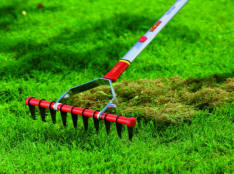10% Guarantee
We will beat any competitors fertilizing programs by 10% Guaranteed. Call for details.Surface Thatching your lawn this spring
By summer's end, does your lawn green on top, but brown underneath? When you mow it, does it look dead and scalped? Thatch is a layer of living and dead grass stems and roots. It is the natural consequence of a healthy lawn, For best results, dethatch your lawn about every one to two years, in March or April or in the early fall. It is best to fertilize after this has been done.
What is Thatch?
It is an interwoven layer of mostly dead roots, crowns, and stems, located between the soil and the green lawn.
Lawn thatching is an important trick of the trade that
Landscapers use. Since thatch builds gradually beneath the grass
surface, it is understandable why most people overlook this
important task.
Why is Too Much Thatch Bad?
- Prevents water and nutrients from reaching the plant roots.
- Absorbs pesticide/fungicide, preventing them from doing their job.
- Reduces space available for new grass. When crowded by thatch, new grass tends to grow rapidly as they seek light and space, thus producing long, thin leaves with shallow roots.
- Grass root systems can grow into the thatch rather than into the soil.
- Harbors diseases such as bipolaris leaf spot, summer patch, and dollar spot.
- Aggravates insect problems. Thatch favors insects by hiding them from their predators.
Regular dethatching forces buds to grow near the base of the grass stems, preventing the grass plants from being dead underneath and only green on top. Thatching frees new grass shoots to grow in thick and lush.

More information